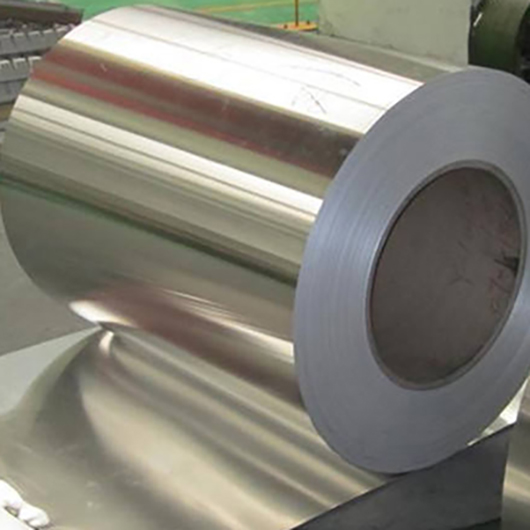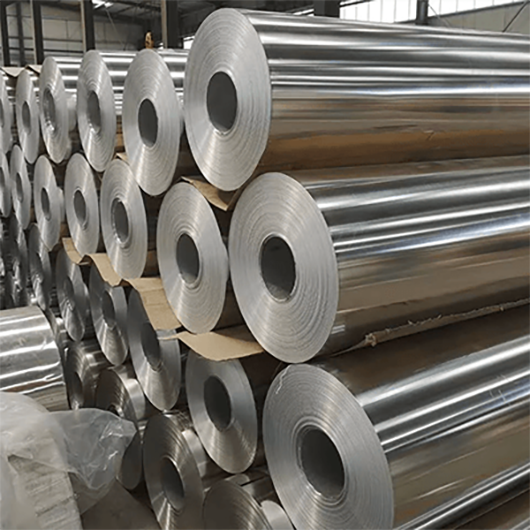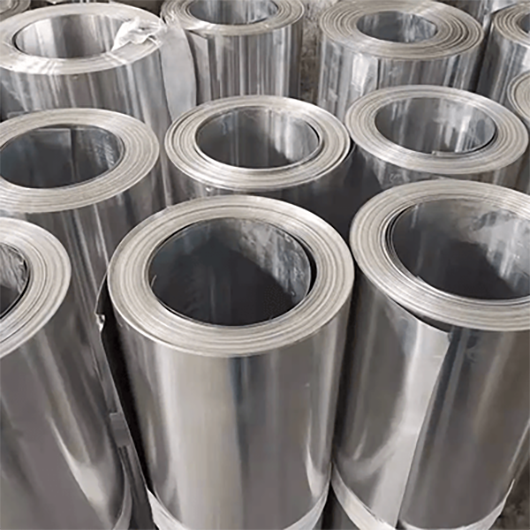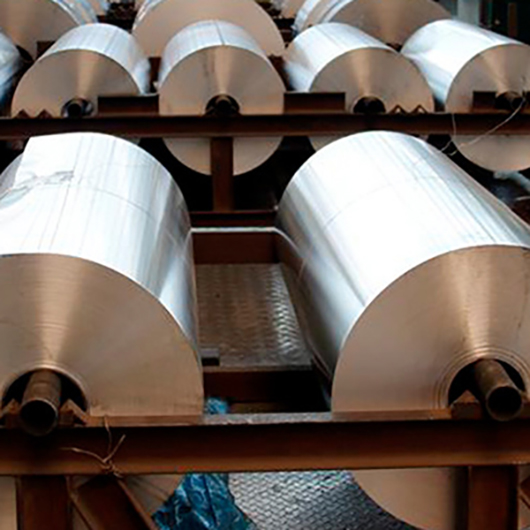Alloy 8011 is a typical alloy for aluminium foil and which is currently the most widely used metal in our daily life.8011 aluminum foils are available in various thickness, width and mill finish with a shiny side and a matte side.
8011 Aluminium Foil Technical Parameter:
| Ingredient | Si | Fe | Cu | Mn | Mg | Cr | Zn | Ti | Other | Al |
| Content | 0.5-0.9 | 0.6-1 | 0.1 | 0.2 | 0.05 | 0.05 | 0.1 | 0.08 | 0.15 | Margin |
| Alloy Type | 8011 aluminium foil | |||||||||
| Alloy State | F, O, H14, H16, H18, H19, H22, H24, H26, H28 | |||||||||
| Thickness (mm) | 0.014-0.2 | |||||||||
| Width (mm) | 100-1600 | |||||||||
| Length | Jumbo roll | |||||||||
Application of 8011 Aluminium Foil
8011 aluminium foil is used for bottle caps: liquor bottle caps, red wine caps, cosmetic caps, milk powder caps, medical caps, beverage caps, yogurt caps, etc. Advantages: food-grade, brushing A grade, low ear rate.
Aluminum foil 8011 is used for pharmaceutical packaging: PTP medicinal aluminium foil, cold stamping plastic foil, 8011-H18 medical packaging aluminium foil, capsule aluminum foil board, etc. Advantages: high cup convex value, high strength of aluminum foil, good sealing.
It is used for food packaging: food packaging, heat sealing foil, lunch box material, container foil, aluminium foil gasket for sealing. Advantages: clean surface, no foreign matter, food-grade, safer.
8011 industrial aluminium foil: aluminium foil for transformer, aluminum foil tape, aluminium foil for cable belt, aluminum foil for filter.
Properties of 8011 Aluminium Foil
High plasticity and corrosion resistance
Electrical conductivity and thermal conductivity
Gas welding, hydrogen welding and resistance welding
Under various pressure processing and extension, bending
Manufacturer of 8011 Aluminium Foil
Aluminium alloy 8011 is a typical alloy for aluminum foil and is currently the most widely used metal in our daily life.
Advantages of CHAL’s 8011 Aluminum Foil
1. The surface clean, uniform colour, no piebald, smooth no pinhole.
2. With excellent moisture resistance, shading and high barrier capacity, mechanical properties, and high resistance to blasting, anti-puncture anti-tearing performance.
3. Non-toxic and tasteless, safe and sanitary.
4. The composite, printing, coating of aluminum foil as a packaging material is widely used.
1235 aluminium foil is the aluminum foil of aluminium content not less than 99.35%, CHAL Aluminium can process 0.014-0.2mm thickness of 1235 aluminium foil, because this product has excellent rust resistance, formability, dissolving ability, then it is widely used in cigarette packaging, cable, capacitor, tape, battery foil, flexible packaging, etc.
1235 Aluminium Foil Technical Parameter:
| Ingredient | Si+Fe | Cu | Mn | V | Zn | Ti | Cr | Other | Al |
| Content | ≤0.65 | ≤0.05 | ≤0.05 | ≤0.05 | ≤0.1 | ≤0.06 | – | 0.03 | 99.35 |
| Alloy type | 1235 Aluminium foil | ||||||||
| Alloy state | O, H18 | ||||||||
| Thickness (mm) | 0.014-0.2 | ||||||||
| Width (mm) | 10-1600 | ||||||||
| Length | Jumbo roll | ||||||||
Application of 1235 Aluminium Foil
1. Food Preparation: Aluminum foil is “dual-ovenable” and can be used in both convection and fan-assisted ovens. A popular use of foil is to cover thinner sections of poultry and meat to prevent overcooking. We also provide recommendations on limited uses of aluminum foil in microwave ovens.
2. Insulation: Aluminum foil is 88 percent reflective and is widely used for thermal insulation, heat exchanges and cable liners. Foil-backed building insulation not only reflects heat but also provides a protective vapour barrier.
3. Electronics: Foil in electrical capacitors provides compact storage for electric charges. If the foil surface is treated, the oxide coating works as an insulator. Aluminium foil capacitors are commonly found in electrical equipment, including television sets and computers.
4. Geochemical Sampling: Aluminum foil is used by geochemists to protect rock samples. Foil provides a seal from organic solvents and does not taint the samples as they are transported from the field to the lab.
5. Art and Decoration: Anodizing aluminium foil creates an oxide layer on the aluminum surface that can accept coloured dyes or metallic salts. Through this technique, aluminum is used to create inexpensive, brightly coloured foils.
Properties of 1235 Aluminium Foil
1. High plasticity and corrosion resistance.
2. Electrical conductivity and thermal conductivity.
3. Gas welding, hydrogen welding and resistance welding.
4. Under various pressure processing and extension, bending.
Products Description
3003 is an alloy with very good corrosion resistance and moderate strength. It is not heat treatable and develops strengthening from cold working only. Main tempers for aluminum foil 3003 include H 18, H22, H24 and other tempers upon request. This alloy provides a better heating and cooling environment so that widely used in household applications.
3003 aluminium foil is a common product of Al-Mn series alloys. Because of the addition of alloy Mn element, it has excellent rust resistance, weldability and corrosion resistance. Similarly, 3003 aluminum foil is also a non-heat treated alloy, so a cold working method is used to improve its mechanical properties, but 3003 aluminium foil with medium strength is 10% stronger than 1 series alloy aluminum foil. In addition, the plasticity and welding performance of 3003 aluminium foil is also very good. So, It is a good choice for aluminum foil for electrolytic capacitor, lunch box container, and aluminum honeycomb core material.
Technical Parameter of 3003 aluminium foil
| Element | Si | Fe | Cu | Mn | Zn | Other | Al |
| Ingredient | 0.6 | 0.7 | 0.05-0.2 | 1-1.5 | 0.1 | 0.15 | Margin |
| Alloy type | 3003 aluminium foil | ||||||
| Alloy state | F, O, H14, H16, H18, H19, H22, H24, H26, H28 | ||||||
| Thickness (mm) | 0.014-0.2 | ||||||
| Width (mm) | 100-1600 | ||||||
| Length | Coil | ||||||
Features and Applications of 3003 Aluminium Foil
AL 3003 alloy is readily machined and is considered as having good machinability for aluminum alloys. Typically, alloy 3003 is used in a number of industries. For instance, aluminum alloy 3003 is easily found in home appliances. From cooking utensils, bakery moulds to office equipment it has many applications that you would find in your everyday lives.
Packing Detail of 3003 Aluminum Foil
The standard export packaging, plastic film or craft paper covered. A wooden case or wooden pallet is adopted to protect products from damage during delivery.
3004 aluminium foil has high hardness, good load-bearing and better stamping effect than 3003 aluminium foil. It can be applied to aluminum foil containers and the products are safe and hygienic. On the premise that the thickness of the aluminum foil is enough, gas and water can be completely blocked. In addition, the use of aluminium foil as lunch box material also has a series of advantages, such as lightweight, good sealing and encapsulation.
3004 Aluminium Foil Technical Parameter
| Ingredient | Si | Cu | Mg | Zn | Mn | Fe | Al |
| Content | 0.3 | 0.25 | 0.8-1.3 | 0.25 | 1-1.5 | 0.7 | Margin |
| Alloy type | 3004 aluminium foil | ||||||
| Alloy state | F, O, H14, H16, H18, H19, H22, H24, H26, H28 | ||||||
| Thickness (mm) | 0.014-0.2 | ||||||
| Width (mm) | 100-1500 | ||||||
| Length | Coil | ||||||
Features of 3004 Aluminium Foil
1. Excellent Punchability. Because the specific gravity of 3004 aluminum foil is lighter, compared to the products of the same size stamped from other materials, the stamping of 3004 aluminum alloy foil is also lighter, and the cost is effectively reduced while the formability is good.
2. Good Anodic Oxidation. The anodized surface-treated 3004 aluminium foil effectively improves the hardness and abrasion resistance of the aluminum foil and also gives the surface of the 3004 aluminum alloy foil a bright and colourful colour.
3. Other Characteristics. Of course, 3004 aluminum foil also has the excellent barrier properties of the aluminum foil itself, and strong light-shielding, air-tightness, oxidation resistance, waterproof, moisture-proof, non-toxic and tasteless, etc., meeting food packaging standards.
Usages of 3004 Aluminium Foil
1. Food Packaging. 3004 aluminum foil can be used in ziplock bags such as dried fruits, BBQ, dessert baking, and other food packages. 3004 aluminium alloy foil ensures good and uniform heat transfer and can be used in traditional stoves and microwave ovens. The most important thing is that the 3004 aluminum foil heated by high temperature will not spill harmful substances to contaminate food. It is safe, hygienic and reliable, which is not possible with other disposable packaging materials.
2. Container Lunch Box. 3004 aluminum foil can also be used as a lunch box material. The thickness of commonly used 3004 aluminium foil for container lunch boxes is generally between 0.03mm and 0.20mm. It can well adapt to all kinds of special equipment and moulds for dining boxes, which can be fully automatic cold stamping and finally made into cuboids, bowls and other shapes, effectively expanding the range of market applications.
Advantages of 3004 Aluminum Foil
1. 3004 aluminum foil raw materials are non-toxic and of good quality.
2. It has no harmful substances that will be produced after heating.
3. 3004 alloy has strong barrier property, can protect the original taste of food after sealing, and extend the shelf life of food.
4. 3004 aluminum foil can be efficiently recycled and reused to protect the environment and save resources.
Aluminum Alloy 8079 Foil Description
Aluminum Alloy 8079 Foil is widely used to produce kinds of Aluminum Alloy Foil, which offers the best properties for many applications with H14, H18, and other tempers and thicknesses between 10 and 200 microns. 8079 Aluminum Foil is a flexible and unique metal with a soft temper and attractive surface. It is an ideal product for applications requiring higher tensile strength materials that are not compromised during the drug packaging processes.
The combination of the 8079 alloy and H18 temper provides optimal performance in pharmaceutical foil. Aluminum Alloy 8079 Foil is also widely used in the food packaging industry, beer mark, and household foil, bottle cap, etc.
Aluminum Alloy 8079 Foil Chemical Properties:
| Si | Fe | Cu | Zn | Other |
| 0.50~0.30 | 0.70-1.3 | ≤0.10 | ≤0.10 | ≤0.15 |
Aluminum Alloy 8079 Foil Specification:
| Products | Type | Temper | Thickness(mm) | Width(mm) | Length(mm) |
| Household foil | Bare, Mill Finish | H111 H12 H14 H16 H18 H22 H24 H26 H28 | 0.01-0.2 | 300-1100 | coil |
| Packaging foil | O H22 H24 | 0.018-0.2 | 100-1600 | coil | |
| Pharmaceutical Foil | H14 H18 | 0.018-0.2 | 100-1600 | coil |
Aluminum Alloy 8079 Foil Applications
Aluminum Alloy 8079 Foil is an ideal product for applications requiring higher tensile strength materials which are not compromised during the drug packaging processes.
The combination of the 8079 alloy and H18 temper provides optimal performance in pharmaceutical foil.
Alloy 8079 foil is also widely used in the food packaging industry, beer mark, and household foil, bottle cap, etc.
Products Description
5052 aluminum foil has stable performance and has many advantages such as clean oil removal, fewer pinholes, good product plate shape, no deformation and good anti-rust effect. Products are widely used in honeycomb materials, door panels, lunch boxes and other fields.
5052 aluminium alloy belongs to Al-Mg series alloy, which is widely used, especially in the construction industry, it is the most promising alloy. Good corrosion resistance, excellent weldability, good cold workability, and medium strength. The main alloying element of 5052 aluminum alloy is magnesium, which has good formability, corrosion resistance, weldability, and medium strength. 5052 aluminium alloy is not only aluminium plate, but also 5052 aluminum foil.
5052 Aluminium Foil Technical Parameter:
| Ingredient | Si | Cu | Mg | Zn | Mn | Cr | Fe | Other | Al |
| Content | 0.25 | 0.1 | 2.2-2.8 | 0.1 | 0.1 | 0.15-0.35 | 0.4 | 0.15 | Margin |
| Alloy type | 5052 aluminium foil | ||||||||
| Alloy state | F, O, H14, H16, H18, H19, H22, H24, H26, H28 | ||||||||
| Thickness (mm) | 0.014-0.2 | ||||||||
| Width (mm) | 100-1600 | ||||||||
| Length | Coil | ||||||||

Application of 5052 Aluminium Foil
As an aluminum plate, 5052 is an alloy with large market demand. As an aluminum foil, the usage rate of O, h18, h24 is high.
The 5052 aluminum foil can be used as a food-grade aluminium foil for making lunch boxes and containers, and it can also be used in architectural decoration In the field, honeycomb aluminium foil is used as the raw material of honeycomb aluminum core.
5052 aluminum foil has good development prospects.
Introduction to 1060 Aluminum Foil
1060 aluminum foil is an alloy foil with 99.6% Al content in 1 series pure aluminum products, so it retains the excellent ductility, corrosion resistance, electrical conductivity, and thermal conductivity of pure aluminum.
Of course, the addition of alloy components also slightly enhances the strength and alloying properties of 1060 aluminum foil, making full use of its various characteristics and applying it in many fields. For example, 1060 aluminum foil is perfectly sealed for pharmaceutical injection due to its excellent stretchability, and 1060 battery aluminum foil has good conductivity and can effectively improve the performance of lithium ion batteries. In addition, 1060 foil has amazed thermal conductivity and is a good choice as lunch box material and so on.
Technical Parameters of 1060 Aluminum Foil
| Typical Alloy | 1060 Aluminum Foil |
| Temper | O、H18、H22、H24 |
| Thickness(mm) | 0.018-0.2 |
| Widthness(mm) | 100-1600 |
| Length(mm) | C |
| Typical Products | Cap material, Food packaging, Aluminum foil gaskets, Electronic labels, etc |
Mechanical Properties of 1060 Aluminum Foil
| Tensile strength σb (MPa) | Yield strengt σ0.2 (MPa) | Elongation δ16 (%) | Electrical conductivity(20℃)(IACS,%) |
| ≥75 | ≥35 | 3月5日 | 62 |
Features of 1060 Aluminum Foil
1. High Electrical Conductivity. Compared to other aluminum alloy foils, 1060 aluminum foil has a strong conductive advantage. Similarly, its thermal and electrical conductivity is second only to copper, silver and gold.
2. Excellent Formability. 1060 aluminum foil has good elongation and processability, strong plasticity, moderate tensile strength, and can well meet conventional processing requirements (such as stamping, stretching, etc.)
3. High Stability. 1060 aluminum foil can withstand high and low temperatures (-20 ° C to + 250 ° C) without changing its performance.
4. Other Characteristics. In addition, 1060 aluminum foil also has good light shielding, insulation and corrosion resistance, and the effect of anodized surface treatment is obvious.

Usages of 1060 Aluminum Foil
1. 1060 Lithium Battery Foil
2. 1060 Aluminum Foil for Injection Vial Seals
3. 1060 Aluminum Foil for Food Packaging
Besides, 1060 aluminum foil can also be used for gaskets, electronic labels, lunch boxes material, and 1060-O aluminum foil for automotive heat shields.






